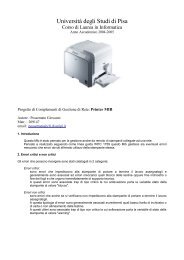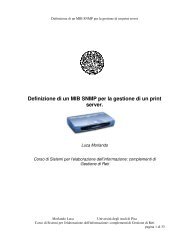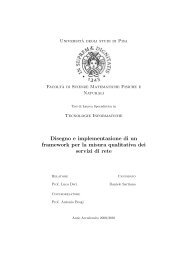vPF_RING: Towards Wire-Speed Network ... - Luca Deri - Ntop
vPF_RING: Towards Wire-Speed Network ... - Luca Deri - Ntop
vPF_RING: Towards Wire-Speed Network ... - Luca Deri - Ntop
Create successful ePaper yourself
Turn your PDF publications into a flip-book with our unique Google optimized e-Paper software.
mmap()<br />
Application 1 Application 2<br />
ring ring<br />
Enhanced<br />
drivers<br />
PF_<strong>RING</strong><br />
Standard<br />
Linux <strong>Network</strong> Stack<br />
Standard<br />
drivers<br />
Figure 5. PF_<strong>RING</strong> Architecture<br />
user-space<br />
kernel<br />
In order to reduce the number of poll() calls and thus a<br />
continuous poll()-wake up-poll() transition, the PF_<strong>RING</strong><br />
kernel module implements a dynamic polling mechanism<br />
that can be configured by packet capture applications. The<br />
poll() system call returns when at least X packets are<br />
available, where X can range from one to several thousand,<br />
or when the call times out, usually this is set to 10 msec.<br />
This mechanism allows CPU cycles to be preserved for<br />
those applications that do not need to process packet<br />
immediately, but it also enables low-latency applications to<br />
be implemented setting X to one.<br />
As described above, the approach followed by PF_<strong>RING</strong> is<br />
to create a straight path for packets bypassing the operating<br />
system standard mechanisms by means of a memory-map<br />
from kernel-space to the address space of the monitoring<br />
application. With this solution, system calls other than the<br />
poll() are completely avoided. The operating system bypass<br />
approach is adopted in many research projects [23] [24] as<br />
well as commercial products such as those manufactured<br />
by companies such as Endace and Napatech, most of all in<br />
areas requiring intense I/O activity, and where low latency<br />
and high bandwidth are vital.<br />
2.4 Hypervisor Bypass<br />
The hypervisor involvement in all the VM I/O accesses<br />
ensures isolation and system integrity, but it also leads to<br />
longer latency and higher overhead compared to native I/O<br />
accesses in non-virtualized environments, thus becoming a<br />
bottleneck for I/O intensive workloads.<br />
In this paper, we propose a model that extends the<br />
PF_<strong>RING</strong>’s operating system bypass approach to the<br />
context of virtual environments, thus creating a direct<br />
mapping between the host kernel-space and the guest userspace.<br />
This approach aims to perform operations that<br />
require intensive workloads such as packet capture using a<br />
direct VM-to-physical host path, without the involvement<br />
of the hypervisor except during the setup phase. It is worth<br />
to note that as in native PF_<strong>RING</strong>, this does not mean that<br />
the hypervisor is completely bypassed in all operations, but<br />
just for those that are computationally expensive such as<br />
packet capture while it is still used for implementing packet<br />
polling. In this view, hypervisor overhead does not affect<br />
packet capture performance because this component is<br />
fully bypassed when packets are read from the PF_<strong>RING</strong><br />
ring sitting on the host.<br />
Hypervisor<br />
bypass<br />
Application<br />
Operating System<br />
Figure 6. Hypervisor Bypass<br />
user-space<br />
kernel-space<br />
The hypervisor-bypass approach is not a novel idea: selfvirtualized<br />
devices for direct I/O, such as SR-IOV [35]<br />
capable ones, are an example. There are also some studies<br />
in the context of High Performance Computing (HPC) [6]<br />
[7] that have demonstrated that the hypervisor-bypass<br />
method can represent a very good solution in order to<br />
remove bottlenecks in systems with high I/O demands,<br />
especially those equipped with modern low latency and<br />
high bandwidth network interconnects.<br />
3. <strong>vPF</strong>_<strong>RING</strong> DESIGN PRINCIPLES<br />
In this section, we present the design and implementation<br />
of Virtual PF_<strong>RING</strong> (<strong>vPF</strong>_<strong>RING</strong>), that is based on vNPlug,<br />
a framework implementing the hypervisor-bypass, also<br />
developed by the authors. Although the work presented on<br />
this paper addresses general issues that are not dependent<br />
on a specific virtualization framework, the authors focus<br />
only on KVM as it leverages Linux kernel capabilities,<br />
such as scheduling and memory management. KVM is a<br />
small and relatively simple software, present out-of-thebox<br />
on the majority of Linux distributions, contrary to<br />
other similar solutions such as Xen that is not integrated<br />
into the mainstream kernel. Proprietary solutions such as<br />
VMware [38], which is widely accepted in the industry,<br />
have not been taken into account due to their license<br />
restrictions and because of the source code not being open<br />
and available [20].<br />
KVM implements a kernel-based virtual machine on top of<br />
the Linux kernel, and exploits a modified version of<br />
QEMU [25] for emulating I/O devices. Implemented as<br />
kernel module, KVM supports native code execution by<br />
exploiting hardware virtualization extensions such as Intel<br />
VT and AMD Secure Virtual Machine. Common tasks,<br />
such as scheduling and memory management, are delegated<br />
to the Linux kernel. VMs run as conventional user-space<br />
VM<br />
Host<br />
Hypervisor<br />
user-space<br />
Operating<br />
System<br />
kernel-space<br />
bypass<br />
Operating System<br />
PF_<strong>RING</strong>






